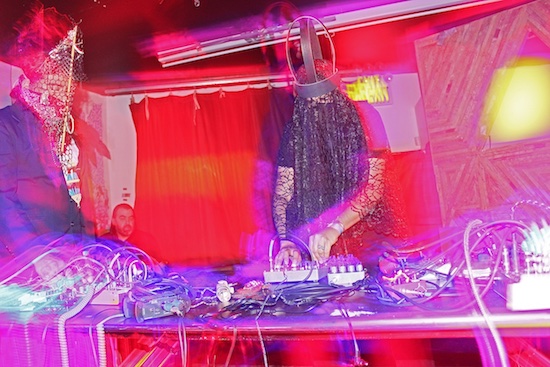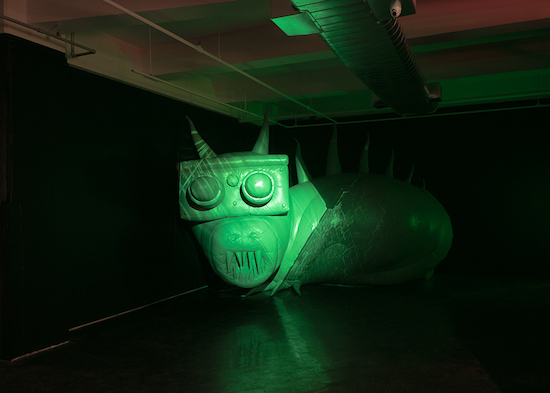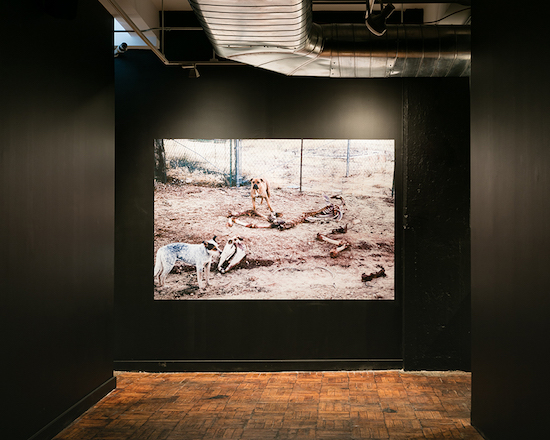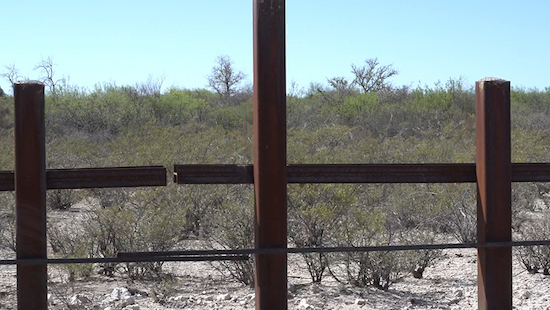Having only known the multimedia indigenous art trio Postcommodity for their visual art work, and specifically their recent exhibition at Artists Space and piece A Very Long Line at The Whitney Biennial, I was fairly surprised to find out that they are also working noise musicians, and even more surprised when they told me that they’d be performing at the End Tymes Noise Festival that Bob Bellerue curates every year at The Silent Barn in Brooklyn. I used to be something of a noisenik, and still like to check into the scene once in a while, and was planning on attending anyways. Eager to meet the three mysterious faces behind the art of Postcommodity, I made the trek.
Though I shouldn’t have been, I was fairly bewildered to see the three hyper-intelligent and academic guys that I spoke to on the phone just days prior throwing back beers, smoking weed, and rubbing elbows with some of American noise’s more boisterous iconoclasts, including Rat Bastard (aka Frank Falestra) and Jean Rollins. Postcommodity in the noise scene appeared a far different enterprise than Postcommodity in the highfalutin art world of museums and galleries.
When the trio stepped on stage, however, the group’s overarching conceptual framework came into focus. Wearing self-made masks and welding a variety of noise making tools, the group blasted into a dizzying blend of high-end frequencies interrupted by vast swathes of ambient lullabies. Trading sounds and seemingly signature body movements and dances, the group locked into the eternal bliss of the night; the sound and performance could have served as a ceremonial offering to the spirits under different circumstances. And that is where noise fits into Postcommodity’s larger bodies of projects: Postcommodity seeks to bring an indigenous viewpoint in contemporary art practices, paying homage to their people and heritage while utilizing the tools available to them in the modern world.
They do not want to be limited by the “Native art” label that their contemporaries are so often falsely tagged with, but they also do not want to detract from who they are and where they come from. They celebrate their blood while recognizing their place in this contemporary world. They are not forcing any viewpoint on to anyone, instead, they only seek to bring back context to contemporary discourse. That all-important underlying meaning that shapes unvarnished truth. “The removal of context is a failure of high speed communication systems,” says Cristóbal Martinez. “You cannot have meaning without context. Dialogue is our ceremony. It requires patience, and listening. Those are our values.”

Photo by Adam Lehrer
Postcommodity is three men, three artists, three musicians, and three humans of a shared Mexican and indigenous descent that hail from the American Southwest. The aforementioned Martinez is a New Mexico-born artist, musician, and academic (while rampantly pursuing art and music, Martinez has found time to earn a Doctorate at Arizona State University in Rhetoric, Composition and Linguistics and is currently a post-doctoral fellow at the same school). Raven Chacon, born in Arizona, is an artist (he has exhibited art work at the Sydney Biennale and Chaco Canyon, among other venues), composer (he studied music with electronic composer Morton Subotnick and free improvisation composer Wadada Leo Smith), and noise musician (you are just as likely to find him performing solo noise and playing in a duo with Bellerue called KILT as you are to hear his chamber music compositions). Kade L. Twist is an inter-disciplinary artist that has exhibited work at The Chelsea Museum and The Toronto Art Gallery and works as a public affairs consultant specializing in American Indian Health Care and community development.
The three artists came together as Postcommodity in the early 2000s and have since lent their respective skills and intellects to a singular – albeit encompassing – conceptual mission: hacking societal frameworks to instill indigenous viewpoints into contemporary discourse surrounding politics, economics, and sociology. “The only way we can enter a dialogue and structure a conversation to bring indigenous views into that conversation is to hack our way to that point,” says Twist. “There aren’t invitations extended. It’s a way to bring our knowledge system to the table so that these ideas can be thoughtfully considered.”
When discussing the failure of social media and digital communication, one must consider the effects it has had on contemporary art. In some respects, the internet has had positive ramifications. More than ever before, artists of different colors, genders, and sexualities are emboldened to share their own work, build a following, and earn gallery representation on sheer popularity alone. But that can also be problematic, as young artists seem to bypass serious criticism and break into realms of the art world that they just don’t deserve to be at yet. Any artist can post any piece of work on Instagram, and if that works earns enough ‘Likes’ it’s not out of the ordinary that they will be selling that work through a reputable gallery for astronomical sums of money. This trend has resulted in lots of obvious – and sometimes downright bad – art work that says nothing. Somewhere along the line, people started to believe that everyone deserved a shot at art success, in spite of the artist’s actual talent.
This is where Postcommodity’s work is especially refreshing. Utilizing video, performance, sound, sculpture, and installation, Postcommodity makes art that is challenging, necessitating real-time experience to be fully considered. Much like harsh noise music, a lot of the joy found in Postcommodity’s work is felt while stripping yourself of your ego and immersing yourself in it. They utilize truly assaultive aesthetics that leave the viewer vulnerable to processing intellectual information. Only in a kind of meditative state does that work start to click, when the viewer is forced to understand the high-concept ideas imbued into it. This isn’t art made to be shared on Instagram and quickly moved on from; instead, understanding Postcommodity requires mental processing and communication.
“Hacking is breaking into something,” says Martinez. “What they do is take something or change something and leave something behind. That’s sort of what we do. We use discourses other than computer codes. We use the mediums that we apply to making art to break into power structures and bring an indigenous world view to encourage transformation.”

Coyotaje, courtesy Postcommodity
After years of impressive projects, including the 2015 land art project Repellant Fence and the 2013 generative sound project and installation Game Remains, Postcommodity is having a New York moment.
First, curators Mia Locks and Christopher Lew tapped the collective to include work in the Whitney Biennial. The resulting project, A Very Long Line, projects a looped video that gives the viewer the sense of being in a car and driving along the U.S.-Mexico border. The piece is merely suggestive, and utilizes the viewer’s personal associations of all that the border – and all borders in general – represent: separation, imperialism, violence, capitalism, immigration, and any number of feelings or ideas that this area of the United States represents. “Here’s this beautiful place and beautiful land, but to contrast that you have a wall,” says Martinez. “Structurally, this wall has no harmony with the land. Beauty really does mediate the political and economic structures over the area.”
As Locks noted at the Biennial’s opening in March, the world felt like a very different place when the Biennial was in its early stages (pre-Trump, pre-Brexit, but mostly Trump). Postcommodity is quick to note, however, that the issues that arise from A Very Long Line have been a part of discourse since Nixon, and actually Barack Obama deported more Mexicans from the United States than any previous president. “Obama really was the great deporter and he did so beneath a veil of social justice rhetoric,” says Twist. “We’re not responding to Trump we’re responding to things that effect our homes,” continues Martinez.
Across the bridge at Art in General in DUMBO, Brooklyn, Postcommodity unveiled its Coyotaje installation in April. Utilizing sound, photography, sculpture, and closed circuit night vision video, the installation immerses its audience in the perilous journey of humans crossing the border, allowing the viewer to feel an experience that is so often thought of in the abstract. Faced with a multitude of angles to take with the project, Postcommodity honed in on the Coyotajes that are literal tricksters tasked with making border crossers think they are trying to help them in order to lure them in and finally whisk them away back to Mexico.
Always trying to understand the balance in human beings and institutions, Postcommodity interviewed two men from Tucson, Arizona Border Patrol who are both of Mexican descent. As gently as they could, to make the men feel as at ease (as much as possible anyway, under the circumstances), Postcommodity tried to understand the conundrum of being charged with keeping people that share your ethnicity out of a country. What they learned was as tragic as it was disturbing. “The agent said he was not Mexican nor Mexican American, but that he was an American protecting the interests of the United States,” says Martinez.
As Postcommodity’s work makes clear, the dehumanizing nature of the border is all-encompassing. Not simply limited to immigrants, it swallows all who engage with it, including those men working for the Border Patrol. “It’s his failure to identify his indigeneity and only defining himself by his national citizenship – and it’s unacceptable in a lot of ways,” says Twist.
In a recent conversation with an exceptional fine art photographer, the photographer argued that art is about aesthetics and should therefore be divorced from obvious political statements. It does seem that the rise of Trump has in many ways led to more hallow and obvious political art work than powerful and complex political art work. If I have to look at one more silly painted portrait of Trump at an art show I’m going to stop going to art shows all together. Enough is enough.
But not Postcommodity. Postcommodity doesn’t engage with simplicity, because simplicity is not the nature of the world, and certainly not the nature of the American Southwest and US-Mexico border. The collective seeks context and balance in all that they examine in efforts to not just bring an indigenous viewpoint into contemporary discourse, but to hopefully use that place in contemporary discourse to enact real change.

Coyotaje, courtesy Postcommodity
Most art is a passive observer, but Postcommodity actively engages. Chacon says that there is an indigenous futurism to the collective’s output (he jokes that they are all a little jealous of Sun Ra’s Afrofuturism), a kind of way forward for American indigenous people. Postcommodity uses the land – in all its physical beauty and political ramifications – to grab at the eternal truths of borders. “We wanted to use that beauty as a medium of discourse,” says Chacon, “One thing that seems to be missing from the canon is the land’s connection to the people and vice versa. I’m interested in artists who are using land to speak to the people that inhabit the land.”
They are not seeking to change minds so much as they are trying to de-silence the voices of their people. “Our work is really about mediating complexity,” says Martinez. “We’re trying to show the system of how trans-border systems operate. We’re making work that demonstrates that the politics surrounding this area are more complicated than partisan agenda.”
Postcommodity, A Very Long Line, is at the Whitney Biennial until 11 June. Coyotaje is at Art in General until 3 June


